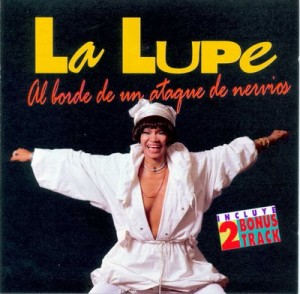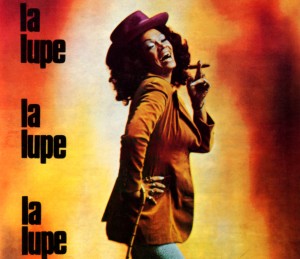 La Lupe (born Guadalupe Victoria Yolí ) (Santiago de Cuba, 23 December 1939[1] – Bronx, New York City, New York, 29 February 1992), was a Cuban singer of several musical genres: boleros, guarachas and Latin soul in particular. Known for her energetic, sometimes controversial performances, she is considered by many to be one of the leading singers in the salsa music genre.
La Lupe (born Guadalupe Victoria Yolí ) (Santiago de Cuba, 23 December 1939[1] – Bronx, New York City, New York, 29 February 1992), was a Cuban singer of several musical genres: boleros, guarachas and Latin soul in particular. Known for her energetic, sometimes controversial performances, she is considered by many to be one of the leading singers in the salsa music genre.
La Lupe was born in the barrio of San Pedrito in Santiago de Cuba. Her father was a worker at the local Bacardi distillery and a major influence on her early life. Her introduction to fame was in 1954, on a radio program which invited fans to sing imitations of their favorite stars. Lupe bunked off school to sing a bolero of Olga Guillot’s, called Miénteme (Lie to me), and won the competition. The family moved to Havana in 1955, where she was enrolled at the University of Havana to become a teacher. Like Celia Cruz, she was certified as a schoolteacher before she became a professional singer.
Lupe married in 1958 and formed a musical trio with her husband Eulogio “Yoyo” Reyes and another female singer. This group, Los Tropicuba, broke up along with the marriage in 1960. She began to perform her own act at a small nightclub in Havana, La Red (The Net), which had a clientele of distinguished foreigners. She acquired a devoted following, which included Ernest Hemingway, Tennessee Williams, Jean-Paul Sartre, Simone de Beauvoir and Marlon Brando. She also performed regularly on radio. She released her first album, Con el Diablo en el cuerpo (With the Devil in my body) in 1960, for RCA Victor, which was later certified gold. Her first television appearance on Puerto Rican television caused a stir due to her frenzied, vibrant performance, which reportedly shocked some viewers.
In 1962 she went to exile to the United States. In New York City she performed at a cabaret named La Barraca, where she was discovered by Mongo Santamaría and started a new career, making more than 10 records in five years. She married a second time, to salsa musician Willie García, with whom she had a daughter. That marriage also ended in divorce.
Lupe’s passionate performances covered the range of music: son montuno, bolero, boogaloo, venturing into other Caribbean styles like Dominican merengue, Puerto Rican bomba and plena. It was her recordings which brought Tite Curet Alonso into prominence as a composer of tough-minded boleros in the salsa style. In the 1960s she was the most acclaimed Latin singer in New York City due to her partnership with Tito Puente. She was the first Latin singer to sell out a concert event at Madison Square Garden. She did a wide variety of cover versions in either Spanish or accented English, including “Yesterday”, “Dominique” by The Singing Nun, “Twist & Shout”, “Unchained Melody”, “Fever” and “America” from West Side Story. FRED WEINBERG, who was her favorite audio engineer, and who also produced several of her albums, called La Lupe “A Huricane” in the studio due to her intense singing, and enthusiasm. (Weinberg can be seen in the PBS Documentary “THEY CALL ME LA LUPE” Directed by Ela Troyano.
The quality of her performances became increasingly uneven. There were persistent rumours of her drug addiction,(Untrue states Fred Weinberg, who worked with her on most of her albums, for many years.”If anything, she clung to Religion and never even saw her take a drink” and her life was “a real earthquake” according to close friends. She ended some of her on-stage engagements being treated with an oxygen mask. Although she may have been poorly managed by her label Fania Records in particular, she managed and produced herself in mid-career, after she parted ways with Tito Puente.
Religious beliefs.
A devout follower of Santería, she continued to practice her religion regardless of the influence, fortune, and fame she had acquired throughout the height of her career. Her record label, Fania Records, ended her contract in the late 1970s, perhaps simply because of falling sales. She retired in 1980, and found herself destitute by the early 1980s. In 1984 she injured her spine while trying to hang a curtain in her home; she initially used a wheelchair, then later a cane. An electrical fire made her homeless. After being healed at an evangelical Christian Crusade, La Lupe abandoned her Santería roots and became a born-again Christian. In 1991, she gave a concert at La Sinagoga in New York, singing Christian songs.
Death.
She died of a heart attack on 29 February 1992 at 52 years of age. She was survived by her second husband William García, son René Camaño (from her first marriage) and her daughter Rainbow García (from her second marriage). She is buried in Saint Raymond’s Cemetery in the Bronx.
Discography.
Original LPs.
Con el Diablo en el cuerpo 1960 Discuba LP
La Lupe is back 1961
Mongo introduces La Lupe 1963
The King swings, the incredible Lupe sings 1965 (with Tito Puente)
Tú y yo 1965 (with Tito Puente)
Homenaje a Rafael Hernández 1966 (with Tito Puente)
La Lupe y su alma venezolana 1966
A mí me llaman La Lupe 1966
The King and I 1967 (with Tito Puente)
The Queen does her own thing 1967
Two sides of La Lupe 1968
Queen of Latin soul 1968
La Lupe…”El Carbonero”
La Lupe’s era 1968
La Lupe is the Queen 1969
Definitely la Yiyiyi 1969
That genius called the Queen 1970
La Lupe en Madrid 1971
Stop, I’m free again 1972
¿Pero cómo va ser? 1973
Un encuentro con La Lupe – with Curet Alonso 1974
One of a kind 1977
La pareja 1978 (with Tito Puente)
En algo nuevo 1980. Last original album
Compilations.
Lo mejor de la Lupe Compilation, 1974
Apasionada Compilation, 1978
La Lupe: too much 1989. Compilation from Tico recordings only, by Charly Records LP HOT 123
Dance with the Queen 2008
La Lupe greatest hits 2008
Religious albums 1986–89
La samaritana
Te amo porque me amaste primero
Dios no es hombre para que mienta
La Lupe en Cristo
Fiebre (Fever)
Crazy love
Qué te pedí?
La tirana [Tico SLP 1167]
Puro teatro (Pure theatre) [Tico SLP 1192]
Adíos (Goodbye)
Carcajada final (Last laugh) [Tico SLP 1176]
A Benny Moré [Tico CLP 1310]
Films, theatre.
La Lupe: my life, my destiny: theatrical production by Carmen Rivera (2001).
La Lupe: Queen of Latin Soul film by Ela Troyano (2003; 2007)
La Reina, La Lupe by Rafael Albertori (2003).
Popular Culture.
* In the 1990s, interest in her music was re-sparked when Pedro Almodóvar included Puro Teatro, one of her boleros of love and breakup in his film ‘Women on the Verge of a Nervous Breakdown’.
* In her 1964 essay “Notes on ‘Camp'”, Susan Sontag lists La Lupe as being part of the Camp canon.
* Her recording of La Virgen Lloraba was used in the 1996 film ‘The Birdcage’.
* In 2002, New York City renamed East 140th Street in The Bronx as La Lupe Way in her memory.[12]
* Cuban-American writer Daína Chaviano pays homage to La Lupe in the novel The ‘Island of Eternal Love’ (Riverhead-Penguin, 2008), where the singer appears in a cameo singing Puro Teatro.
* On the TV series RuPaul’s All Stars Drag Race, Puerto Rican drag queen Nina Flowers chose to impersonate La Lupe.
* Her recording of Fever was included in the episode “Angels of Death,” from season two of the Starz series Magic City.
* A poem by Victor Hernández Cruz La Lupe
Agencies/Various/Wiki/InternetPhotos/youtube/thecubanhistory.com
The Cuban History, Hollywood.
Arnoldo Varona, Editor.





